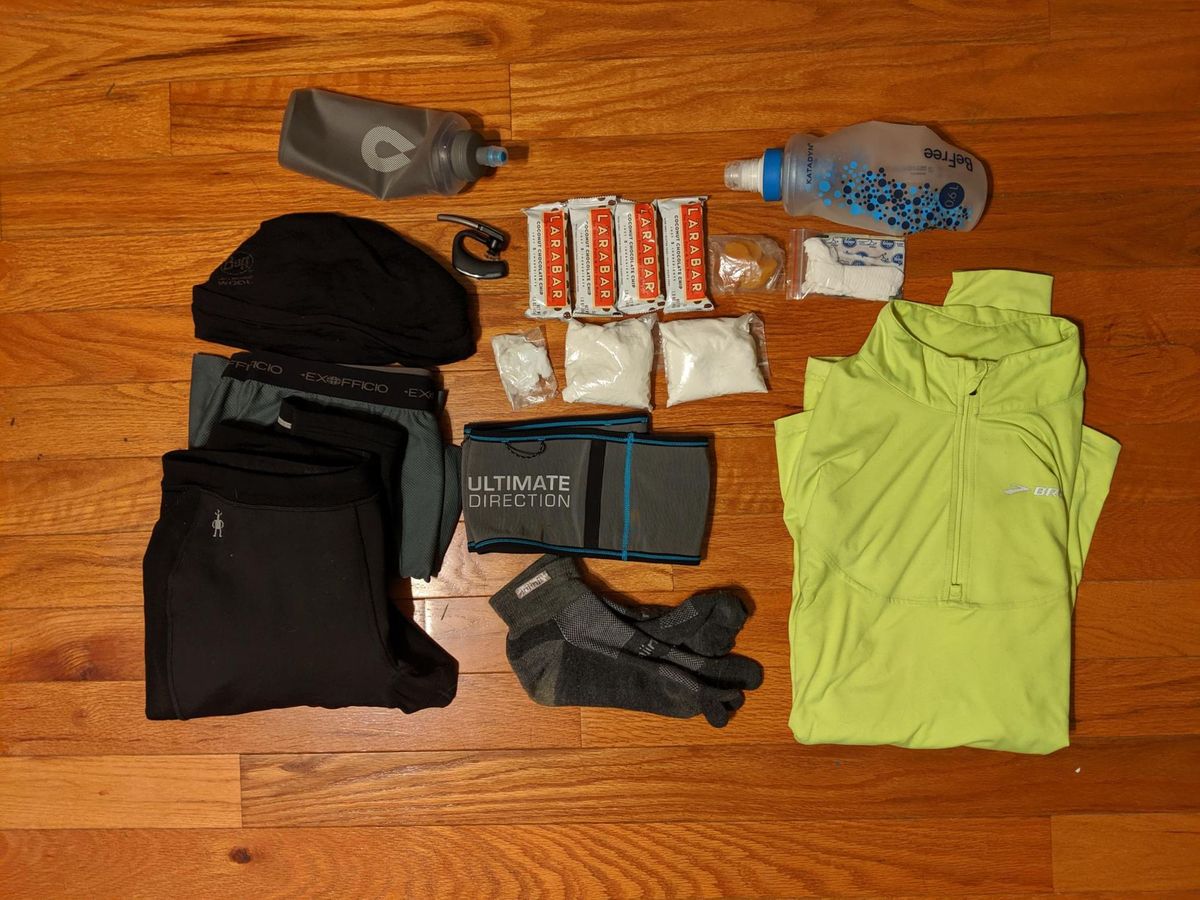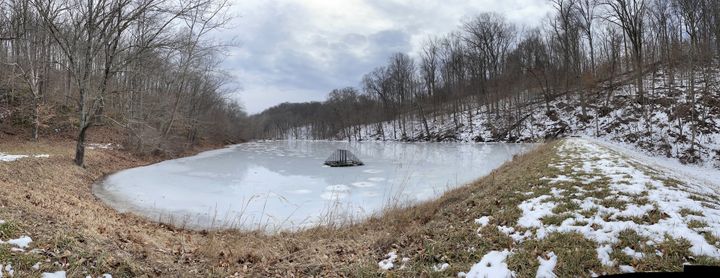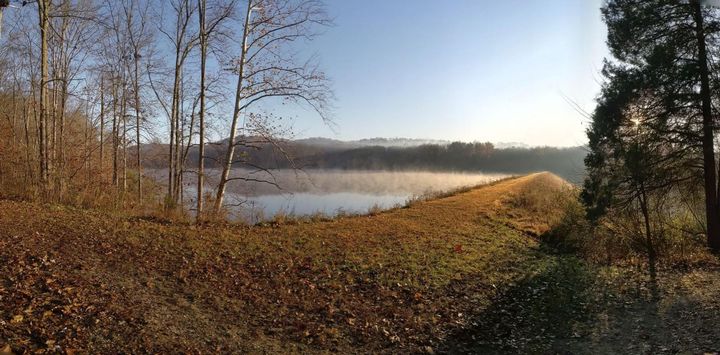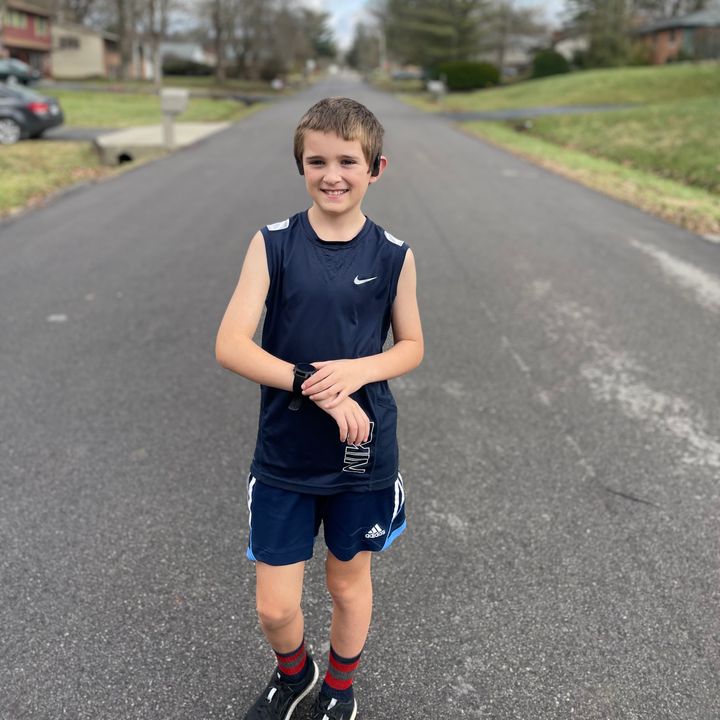How I ended up running 5 marathons in 5 weeks in the spring of 2020, and even more in the fall

A recap of my 2020 running season.
I got this idea in December of 2019 to start 2020 with a reflective day of running: a solo, self-supported, 50k run. Try to spend most of the run unplugged, not looking at the stats of my GPS watch-- just out there running. Resetting. Reflecting.
It's a nice idea, but planning to spend all day outside sweating mid-winter on remote trails can a risky affair in Indiana. I committed to trying if temps were above 18F or so. I created a route that went by a store that would be open about once per hour on the route-- creating a safe bail-out option if things went south at any point. By climate-change worked in my favor on this day, with temperatures starting out at 28 degrees-- I decided to run in shorts with calve sleeves a simple, single-layer long sleeve shirt.
I left around dawn and was able to get Scenic View Restaurant about 6 miles later just in time to see the sun rise above Lake Monroe. My long run and my 2020 were off to a good start.
Maybe cause it was cold out, my mood on this run was stay in motion. Although I didn't have pace or time goals, I minimized my break times. As I approached a forest stream about once per hour to refill my water, I would approach with filtering flask in one hand, ready go. Stop. Scoop water into the flask. Scoop once more, then I was on the move again. The last six miles were labored but I ended up posting my best 50k time of 5:30, despite it being a self-supported adventure focused on rejuvenation. 2020 was off to an auspicious start.
The pandemic curveball
When the pandemic closures started to hit in March, I had been training for a 50k (31 mi) trail run. That was the Knobstone Knockout, scheduled for mid-march.
Like so many events, it was cancelled. But my schedule was free on March 15th and my legs were ready, so I decided to plan my own adventure that day. I settled on what I called the "Nashville Lunch Run".
I live in Bloomington, Indiana and Nashville, Indiana is a cute small town about 20 miles away. In between our two towns sits Yellowwood State Forest. I had recently seen some folks post a 20-mile run on Strava that went from Bloomington to Nashville that made a connection through some of those forest trails and stayed off all the main roads.
I thought Aha, that's what I want to do... except I want to eat lunch in Nashville and run back. My logic was that this route was flatter than the tough 50k trail race planned for the day, so the fact that it was 37 miles instead of 31 would be a comparable challenge.
The first 18 miles to Nashville went well. Kerr Creek is a narrow road with a stream and steep hill on once side, with farms on the other. The section through Yellowwood involved hopping some streams, climbing 300' hills and running along wooded ridges all to myself. The highlight is crossing by the dam at the lake, with a full view of the lake and woods beyond stretching out. A lot of the remaining route is quite gravel roads along Green Valley. I arrived tired and ready for a break in Nashville, but so far the fatigue of the first 20 miles felt familiar from some training runs.
My lunch choice was veggie fajitas from the local Mexican restaurant. I met some friends who lived there, chatted and ate. As they drove away, I hoped they couldn't see that my walking was strained. bMy legs didn't feel in prime shape for another 18 or 19 miles on a full stomach.
I talked to my legs. "We can do this". No answer. I pounded on them a bit to revitalize them, and gave myself permission to quit halfway home if it didn't go well... assuming I could find cell reception in the forest.
I focused on forward motion and not my pace and just going. I focused on the small milestones in-between lunch and home: Getting back the forest, climbing the next hill. I put on a podcast to distract myself. And I took more breaks. I wearing down, but there were no signs of injury, only fatigue, so I persisted. By the last hill my legs were heavy, my brain felt foggier, and my body seems less obedient to requests for forward motion. But my legs keep going, my house came into view, and I finished!
Now what? Spring marathons of 2020
Around the same day, my work moved to fully "work from home" and just about all businesses and events were closed. So after a week of working and running from home, I was ready for something different on the weekends... but options were very limited.
I considered running back to Nashville and back again, but now the restaurant would be closed, and two 38-mile runs two weeks apart would be crazy, right?
I dialed back my ambitions and decided to run only as far as Yellowwood Lake two weeks later, which would be about 22 miles. The time in nature was rejuvenating. My long run was a kind of meditation in motion-- a welcome reset from spending days in my home home and nights in the same house.
When I was about four miles from home, I was tired and my left knee was hurting some, but thoughts crept in that maybe after a break at home, I'd go back out to turn this into a 26.2. I didn't feel great... but I felt good enough... except for my knee.
At my kitchen able with a recovery drink in hand, I came up with this logic: If I kept the pace easy, I expected my knee would feel no worse after 26 than 22, than why not? With that twisted logic, I set out again. But that intuition was correct. My knee held and my marathon-distance run was complete.
I felt recovered by mid-week and planned another 20ish mile run. I was learning an easy, cruising pace. I gave myself permission to go slower and take breaks as I pleased-- the focus was on the enjoyment. I arrived home after 22 miles. The weather in the 40's (F) was perfect for running, so I again I went back out, but this time felt ready to push the pace for the last four miles, finishing with my fastest mile of the run!
By that third weekend, I understood: I might as well plan a 26.2 run. I picked a loop that had some gravel roads and monster hill in the middle, and went ahead and pushed the pace some since I was now familliar with the 26.2 distance.
The "McGowan Marathon" route was flooded. Oops. I persisted at first, running through some ankle-deep water. I ran into more flooded roads, but given where I was in the route, I felt committed to find a way forward. I hiking up a steep hill to bypass a flooded section and used a "balance beam" log across another flooded bit. After conquering the flooded section, I felt strong on the second half and was able to drop a number of fast 7:30 miles on the way back.
There was no master plan, there was just nothing else going on. I keep recovering and thinking of new 26.2 routes to try.
The marathon I wanted to quit: Morgan-Monroe from Marlin
I hard started these runs with some humility, but I couldn't deny that last one had gone quite well. On flat road section I'd been able to run fast going out and faster going back, feeling relaxed with 7:30 miles on the way back.
So the next weekend I amped up my challenge. To reach some trails I hadn't been to this spring, I would first bike 5 miles to the edge of town just to start the run. This would involve biking down to Lake Griffy with a long climb back up to the ridge line. I conceptualized this as as a "warm up" that shouldn't really count towards my total effort. I'd need to bike home at the end as well. The route itself included almost 2,000 feet of elevation gain, mostly grouped into 6 monster climbs, most of which are fair to say are not very "runnable":

Locally may recognize the Miller Road and Boltinghouse climbs on the way back. In the middle there are four miles of trails on the backside of the "Three Lakes" trail.
If there was a route to run with humility, it would be this one. But I set out like I was ready to crush it. And considering the conditions, things went fairly well until about mile 22. I'd run out of Tailwind to drink and my energy was flagging. It was only about a downhill mile to my next filter stop at the creek at the base of the Boltinghouse hill, but I felt bad enough to slower down the hill instead of faster. Or maybe may quads were trashed from all the hills. That part's a fog. But what's clear is that I made a tactical error at my filter stop. Because I felt bad, I "just wanted to get it done". In my head, the end was near: I "just" needed to run up Boltinghouse hill and finish on the fairly-flat Bethel Road. So I stopped briefly at the filter stop without fully refilling all my water and Tailwind and kept going.
Maybe it was the grind up Boltinghouse hill that cleared my head: I needed those calories and water and now I'd missed my last chance. Earlier in the run, my fast miles were 7:30, now now they had dropped to 9:30 and felt like an absolute slog. For the first time of these run, I seriously not enjoying myself.
I had the good sense to have stashed a couple recovery drinks on bike back at Marlin Elementary, but found myself less excited about the epicness of needing to bike an additional miles to get home.
It's finished this one, but both my confidence and enjoyment were shaken some. And would I dare return this route for a re-match in the future?
Try this route: The Peninsula Trails Marathon
For the fifth one, I also used a bike to reach more distant trails, but swapped a bike for a e-bike after my last experience. I always swapped a mostly-road route for a mostly-trail route. This would strategically be softer and slower. After ramping up my effort over the past four runs, my run in the Deam Wilderness was to focus on the scenery and enjoyment. A reset.
The route turned out to be amazing, so let's a look at that:

The route starts and ends the Branigan Peninsula Trailhead, seen here in the center park. There's limited car parking there, and folks might not appreciate if you park a car there for four or five hours, so e-biking there from Bloomington worked well there. The route starts by running back to 446 and across the scenic Lake Monroe causeway. From there, you can look east and see two peninsulas in the distance on the north and south sides of the lake. Get ready to run them both!
There's a bit of running on 446 to get the Hayes Road trailhead. From there, the route threads through the Deam Wilderness. You'll need fix the route in the middle and not get lost like me. Near the halfway point, you'll reach the beach at the end of the "Peninsula Trail". Look straight across the lake and see the Branigan Peninsula on the other side. Now it's time to turn around and run back there! Re-trace your steps back to the Branigan Peninsula Trailhead, grab a drink off your back and finish with the super-scenic Branigan Peninsula trail, with is a mile out on a narrow peninsula only to reach the beach and look across to see where you were 12 miles earlier. One more mile back to the bike to finish!
My map was outdated and I got lost in the middle, but my additions and subtractions of mileage worked out perfectly in the end. With 2,600 feet of elevation gain, this was a tough but rewarding route. I look forward to returning!
What? What? How?
By this point, you may be wondering: How does a 45 year-old dude recover from marathon distance runs fast enough to run every them every weekend? And actually get faster each week and not more injured? I was curious about that myself, as I stumbled into this pattern and was taking it week by week.
A couple pillars supported me here. First, these were not all-out race efforts. Second, I credit my diet having shifted from vegetarian, to vegan, to a "whole foods" focus with less processed food. I believe this a high-nutrition, low-inflammation diet that both less prone to contributing to injuries and speeds recovery time as well.
The science and benefits of WFPB are covered in films like Forks over Knives and Game Changers and books like How Not to Die and Fiber Fueled.
For folks near Bloomington, Indiana, I lead a group focused on healthy plant-based eating, PEA Pod, that you are welcome to check out.
Fall of 2020: Tecumseh Trail Challenge 50k... and more 26.2s?
I thought my accidental streak of five 26.2 runs in five weeks in the spring would be a once-in-lifetime fluke. I signed up for the Tecumseh Trail Challenge 50k in mid-October and hoped it wouldn't be cancelled. My wife, 9 and 12 year-old all signed up for the Quarter Marathon of same event.
When they drove out to Yellowwood Lake for a course-preview of the quarter marathon, I started a couple of hours earlier and ran out to meet them, creating my first 26.2 of the fall.
They all wanted to run their 7 mile loop again the next weekend, so again I ran out to meet them, but choosing a different route and trails this time, another 26.2 for me.
At this point my 50k was two weeks away, and I didn't think it was advisable to run another 26.2 the week before this race, but then I got a call out of the blue from an old college friend who asked... if I wouldn't like to meet him in our old college town and run a 26.2 with him. I was like "I would, um, but that's six days before this 50k race..."
I slept on it. If I didn't go too hard, clearly I was able to recover from these runs to something similar a week later. I said OK, and mentally committed to running this "Richmond Marathon" at a controlled effort.
Because I'd never run a marathon only on roads, this was Marathon PR for. My friend's wheels fell off at the end. I was keeping him company at the end, taking more breaks and running slowly, which was probably all the best considering my race the following the weekend.
In the six days between this event and the race I felt mixed about my prospects. Running three 26.2s in the weeks before a 50k was certainly unconventional, and I risked not being fully recovered for my best performance. On the other hand, I saw that I could get faster from week to week was the pattern and I was now very familiar with the kind of pacing and effort that could work for this distance.
By race day, I felt prepared and ambitious. I went out with the lead group, but watch them pull away about four miles again as we started a long climb up and away from the lake. I did not catch them again, but continued to fad gradually for the rest of the race, paying a price for miscalculating what I could sustain. Still, I crossed the finish line to find I'd won 3rd in a competitive age group. This was my best overall trail 50k time, finishing in under 6 hours.
While I felt prepared for the 50k, my pacing was a bit ambitious and I faded gradually throughout the race, still I was able to bring home 3rd in my competitive age group, making that my best overall trail 50k race, finishing in under 6 hours.
My body was clearly adapting to such long runs, because even though I'd raced 50k and not casually run 26.2, my legs again surprised me by recovery by mid-week. And my brain surprised me by dreaming up yet-another 26.2 route I wanted to try. Also, the fall weather was holding out and the pandemic was still raging, so why not?
I followed the pattern of "run commuting" to a trail section, running the trail section and then returning on the roads again. I love that these mixed road-and-trail runs combine some of the faster pacing of the road sections with the scenery and variety of trail sections. The forested bits also give me a chance to filter water from streams to refill my Tailwind.
Still feeling good after that, I returned for a loop around Yellowwood Lake for a sixth 26.2 in six weeks the following weekend.
I broke this streak the next weekend to do a course-preview of the Jackson County 50k course with my nine year-old. The idea was for him to run the 10 mile loop of trails with me. He got some cramps and we cut it short at about 6 miles, but we had a good time.
Rematch with Morgan-Monroe from Marlin!
The next weekend, I was back it. I like to choose goals that make me uncomfortable, that I have some doubts about, but I think I can reach. Goals that scare me a little me. And one run scared me was returning to the route of my worst run of the year, the "Morgan-Monroe from Marlin" route. I wanted a re-match. But I also wanted a better experience, so I considered what I change and improve. So I swapped the bike-commute for an e-bike commute. Before, the only truly reliable water source to filter was mile eight. I kept staring at maps to try to spot another until I had the 💡 idea to reverse the course. This would put the one reliable water source at mile 17. From experience, I knew that I could stretch my first 500ml of Tailwind to last that long if I needed to.
The conditions were 45F and drizzling when I started– a good recipe for hypothermia if things went wrong on the remote trail sections. But on the other hand, steady and 45F was also an ideal temperature if things went well. This was either going to go very well, or be an epic double-fail of this course.
By mile 15 I was already out of Tailwind, with two miles to go until the filter stop. But I wasn't really thirsty and felt OK. Unlike last time, I was able to arrive the filter stop feeling good. And that was my critical moment: I had just one filter stop on this route and I left here without sufficient re-fueling, it was going to be another regrettable slog to finish.
Still, I rushed through executing my refueling plan at Bryan Lake: As fast as I could, I filled the BeFree filtering flask and filtered into a soft flask with Tailwind already waiting in it. Then I quickly scooped water into the filter flask again, capped it, and I was off again. I was now carrying a liter of water for the next 8 miles.
It didn't long for me to drain the first full flask of Tailwind. Now I had a new challenge, I wanted to the filter my reserve 500ml of water into my flask... while keeping a sub 8-minute pace. Sloshing and some water loss ensued. I pulled over and stopped for a minute to finish the filtering. Then I was committed: I was on my last bottle with five more miles to go. But something was different this time. I felt better. The steady 45F and drizzling conditions had been great for performance.
Somehow, against the odds, my watch told me I was on pace for my fastest marathon yet. Despite the 2,000 feet of elevation again. Despite the 4 miles of trails. Despite that this course was the one that crushed my will to go on last time. Here I was, out of water and Tailwind again with two more miles to go. The gaint Old 37 hill was still between me and the finish. But I felt good, prepared. I ignored the watch stats and I pushed the hill as best as I tried to finish strong on the legs I had left.
I'd done it! I won the re-match. Thanks to minimal stopping, this was a marathon PR at 3:46:53, including about 5 minutes of breaks. My flat road miles had averaged about 7:30 while for the monster hills and trails I just held on tried to crest the hills without getting out of breath.
That 50k on December 5th was cancelled, so I decided to run a race-effort half marathon on a favorite 13.1 loop to see if I could PR it. I met that goal, completing it 1:33:32, averaging 7:08/mile.
Wrapping up 2020's Run Report
To recap, by the end of the year I had run 14 runs that were 26.2 or longer, with three being 50k+. After that endurance season finished, I focused on short, fast runs in December. I was closing out the year feeling good about what I'd accomplished with my running both in terms of distance and speed. So what should my running goals for 2021 be? The reality would a different kind of curveball. To read about the different direction my running took in 2021, see Reflections on a year of running with a 10-year-old half-marathoner.
For more reflections on long, self-supported runs, see Seven Lessons Learned from a 37-mile run.



Comments ()